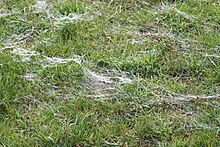Ballooning (spider)


Ballooning, sometimes called kiting, is a process by which
It is observed in many species of
Description
Ballooning is a behavior in which spiders and some other invertebrates use airborne dispersal to move between locations.
Many spiders use especially fine silk called gossamer[13] to lift themselves off a surface, and silk also may be used by a windblown spider to anchor itself to stop its journey.[8] The term "gossamer" is used metaphorically for any exceedingly fine thread or fabric. Biologists also apply the term "balloon silk" to the threads that mechanically lift and drag systems.[further explanation needed]
It is generally thought that most spiders heavier than 1

In Australia, in 2012 and in May 2015, millions of spiders were reported to have ballooned into the air, making the ground where they landed seem snow-covered with their silk.[15]
Distance and height achieved

Most ballooning journeys end after just a few meters of travel, although depending on the spider's mass and posture,[16] a spider might be taken up into a jet stream. The trajectory further depends on the convection air currents and the drag of the silk and parachute to float and travel high up into the upper atmosphere.[17]
Many sailors have reported spiders being caught in their ship's sails over 1,000 miles (1,600 km)[18] from land (Heimer 1988). They have even been detected in atmospheric data balloons collecting air samples at slightly less than 5 kilometers (16,000 ft) above sea level.[19] Evidently, ballooning is the most common way for spiders to invade isolated islands and mountaintops.[18][20] Spiderlings are known to survive without food while travelling in air currents of jet streams for 25 days or longer.[5]
Some mites and some caterpillars also use silk to disperse through the air.[21][22]
A close association has been found between ballooning behaviors and the ability for a species of spiders to survive afloat on water. Water-repellent legs keep them alive on both fresh and salt water, enabling them to survive waves up to 0.5 meters in height. In wind many species raised their legs or abdomens to use as sails, propelling themselves across the water's surface. Many species of spiders also drop silk to anchor themselves in place while afloat. Said spiders did not show these behaviors on land, suggesting that they are adaptations to water.[23][24][25]
History
Although this phenomenon has been known since the time of Aristotle, the first precise observations were published by the
See also
- Charlotte's Web
- Aeroplankton
- "A Noiseless Patient Spider", a poem by Walt Whitman based on spider ballooning behavior
- Organisms at high altitude
- Spider silk
- To Demonstrate How Spiders Fly, documentary short film
References
- ^ a b c "Can spiders fly? They are found 3 miles above ground". The Fact Source. 3 July 2020. Archived from the original on 2020-08-06. Retrieved 2020-08-27.
- PMID 29983315.
- ^ Bell, JR, DA Bohan, EM Shaw & GS Weyman. 2005. Ballooning dispersal using silk: world fauna, phylogenies, genetics and models [ archive ] . Bulletin of Entomological Research 95: 69-114.
- OCLC 54027960.[page needed]
- ^ JSTOR 3704941.
- hdl:10919/29114.
- ^ JSTOR 3705494.
- ^ from the original on 2022-10-09. Retrieved 2022-01-29.
- arXiv:1309.4731 [physics.bio-ph].
- S2CID 245353548
- PMID 29983315.
- ^ Young, Ed (5 July 2018). "Spiders Can Fly Hundreds of Miles Using Electricity". The Atlantic. Archived from the original on 5 July 2018. Retrieved 5 July 2018.
- ^ Oxford English Dictionary 2nd ed.: Gossamer, noun and adjective: fine filmy substance, consisting of cobwebs, spun by small spiders, which is seen floating in the air in calm weather, esp. in autumn, or spread over a grassy surface: occas. with a and pl., a thread or web of gossamer.
- JSTOR 3705999.
- ^ Dell'Amore, Christine (May 18, 2005). "Millions of Spiders Rain Down on Australia—Why?". National Geographic News. Archived from the original on May 21, 2015. Retrieved 2015-05-19.
- JSTOR 3705774.
- JSTOR 3705725.
- ^ doi:10.1071/IT01026.
- ^ VanDyk, J.K. (2002–2009). "Entomology 201 - Introduction to insects". Department of Entomology, Iowa State University. Archived from the original on 8 June 2009. Retrieved 18 July 2009.
- hdl:1811/867.
- PMID 21533150.
- S2CID 37474805.
- PMID 26138616.
- S2CID 186944562.
- S2CID 4405075.
- ^ Glick, P. A. (May 1939). "The distribution of insects, spiders and mites in the air". Technical Bulletin of United States Department of Agriculture (673). Archived from the original on 9 October 2022. Retrieved 28 August 2020.
Further reading
- Dean, D. A.; Sterling, W. L. (1985). "Size and Phenology of Ballooning Spiders at Two Locations in Eastern Texas". The Journal of Arachnology. 13 (1): 111–120. JSTOR 3705236.
- Heimer, S. (1988): Wunderbare Welt der Spinnen. Urania-Verlag Leipzig. ISBN 3-332-00210-4.

